Test – AMD A8 7650K
: Specs | Price | CPU | Profitability| Hashrate| best Coins | Config | Advantage (Pros) and Disadvantages (Cons) and other important features that will help you make better decision.
Hi all!
We continue with the tests of AMD processors with this time a little last of the “Kaveri” family, therefore an APU which bears the sweet name of A8 7650K. Equipped with a CPU part of 4 cores clocked at 3.3Ghz and a graphics chipset (hence the designation of APU) AMD R7 all this in a maximum TDP of 95 Watts and offered at a price of around 100 € it should be perfectly suited to a configuration of casual gamers and office automation, let’s see what the little one has in the stomach!
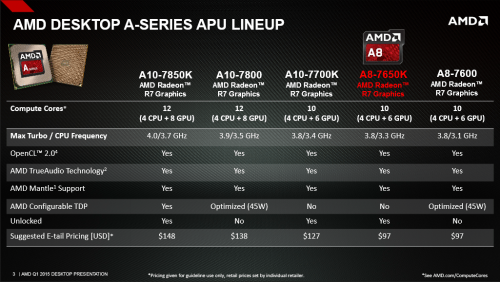
| AMD A8 7650K | |
|---|---|
| Number of modules / cores | 4 CPU cores 6 GPU cores |
| Frequencies | CPU: Turbo: 3.8Ghz Base: 3.3Ghz GPU: |
| Overclocking | Yes, multiplying coefficient released |
| Socket | FM2+ |
| Architecture | Steamroller Kaveri |
| Engraving fineness | 28nm |
| Supported memory | DDR3 up to 2400 MHz |
| CPU cache memory quantity | L2: 4 MB distributed among the cores |
| Memory allocated to GPU | 1 GB at a frequency dependent on the main memory. |
| TDP | 95 Watts |
| Tarif OEM | ~ 100€ |
The A8-7650K is logically placed between the A8-7600 and the A10-7700K, we are entitled to 3.3 GHz for the base CPU with a turbo rising to 3.8 GHz, note that when the CPU and the GPU are working all 2 at the same time significantly (in a game for example) the CPU will drop by a few hundred Mhz, we will see that below. In terms of the integrated GPU, it runs at 720 MHz and is accompanied by 1 GB of memory drawn from the memory that you have installed, it will therefore benefit from a rise in frequency of the memory installed in the PC.
Offered at a price of around 100 € and given its characteristics we can expect a processor which, even if it will not achieve the performance of its big brothers FX or the Core i5 from Intel, it should provide enough juice to hold a configuration of casual / undemanding players, if the tests prove to be up to it!
The configurations
For the tests 2 machines are available, a machine based on an Intel processor and an AMD machine:
Intel:
- Processor: Intel Core i5 4670K
- Motherboard: Gigabyte Z87-UD5H TH
- Memory: Kingston HyperX 4 x 2 Go 1600Mhz
- Hard disk: WD Raptor 150 Go
- Food: Seasonic X650
- Graphic card: Sapphire 7950 Dual-X
- Drivers: Catalyst 14.9
- Operating system: Windows 8.1 64bits
AMD:
- Processor: AMD A8 7650K/li>
- Motherboard: MSI A68HM-P33
- FX processor: AMD FX8320E & AMD FX8370E
- FX motherboard: Asrock Fatal1ty 990FX Killer & MSI 970 Gaming
- Memory: Kingston HyperX 2 x 4 Go 1600Mhz
- Hard disk: WD Raptor 150 Go
- Food: Seasonic X650
- Graphic card: Sapphire 7950 Dual-X
- Drivers: Catalyst 14.9
- Operating system: Windows 8.1 64bits
The test protocol
In order to have results covering a wide range of applications, I chose the following benchmarks:
- Fritz Chess
- WinRAR 5.11 64bit: integrated benchmark
- Wprime 2.10: benchmark 32M
- Cinebench R15: benchmark 1 thread et Multhread
- Handbrake: encoding of a 600MB Full HD avi file to mkv
- Unigine Heaven 4.0
- 3DMark Fire Strike Physics
- Bioshock Infinite: Medium quality, integrated benchmark
- Tomb Raider: Normal quality, without AA or TressFX and Vsync off, integrated benchmark
Note that GPU tests (benchmarks and games) are only done on processors that have a graphics part, namely the A8 7650K and the Intel Core i5 4670K. All this little world is tested at 1920 x 1080, which is the current “standard”.
Frequencies
Repos:
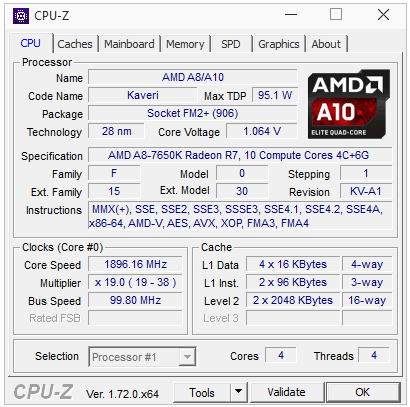
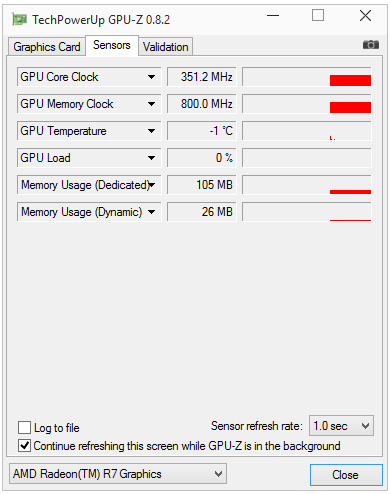
At rest as we can see the CPU runs at 1.90 Ghz for 1.064V, the GPU is flashed at 351 Mhz (and 800 MHz for the memory, which uses the main memory, I remind you).
CPU only supported:

When all the CPU cores are loaded at the same time, and without any load on the GPU part, the A8 7650K stabilizes at 3.5 Ghz (for 1.4V), which is 200 Mhz as the base frequency, when only one core is put to use it goes up to 3.8 Ghz but in the end we must expect to be at 3.5 Ghz in 95% of cases.
GPU only supported:
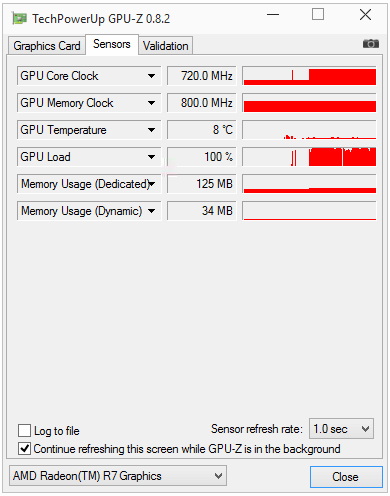
If only the GPU is in charge, the frequency goes well to 720 Mhz and remains at this level throughout the tests.
CPU et GPU en charge:

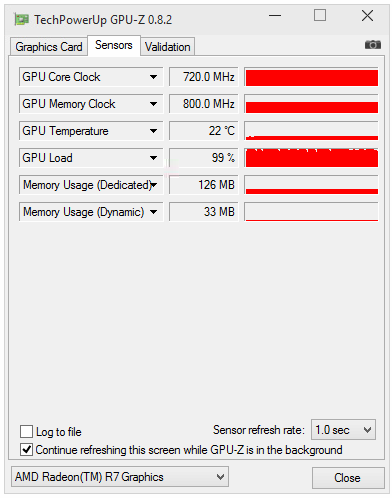
Change when both the GPU and the CPU are under load (in a game for example) the CPU part drops from the 3.5 Ghz that we saw above to 2.8 Ghz, certainly to stay in the TDP of 95 Watts (the voltage is lowered from 1.4V to 1.18V), this is still a good drop even if in the end it should not impact performance too much.
Performances Applications
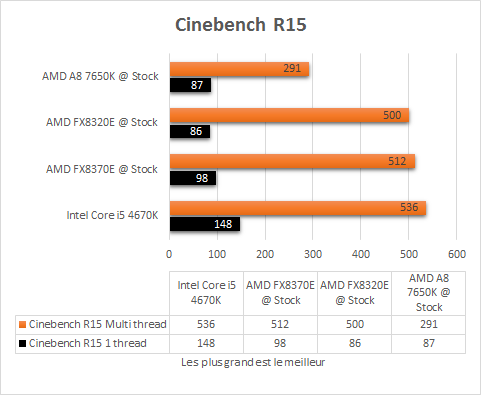
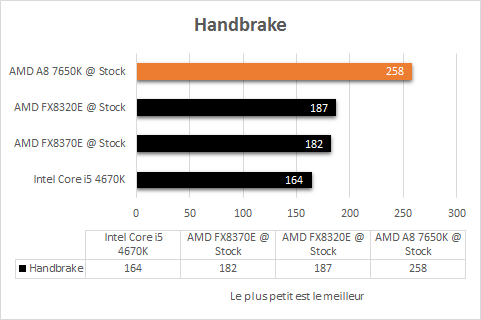
As we can see on the CPU side, the small A8 7650K holds up very well, despite the fact that it only has 4 cores compared to its big brothers the FX8xxx. The A8 7650K is around 40% less efficient than an FX8370E, which is normal anyway given the price placement of today’s small APU. Despite everything, he will still be quite capable of doing what others are doing in today’s comparison, especially in everyday use (surfing the internet, watching films, encoding films from time to time etc. ), however, it is not really suitable for “heavy” use.
3D Performances and Games

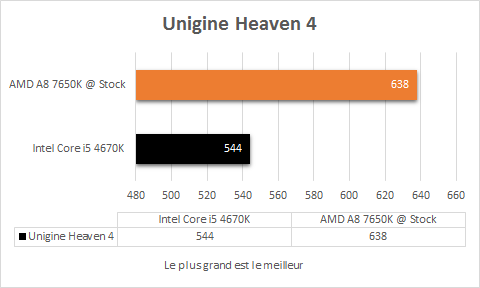
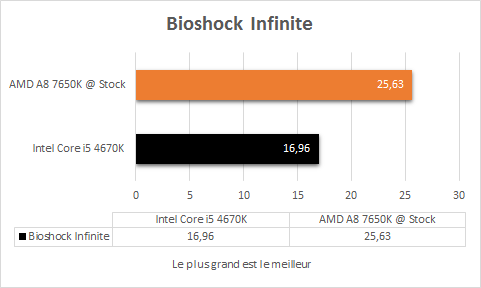
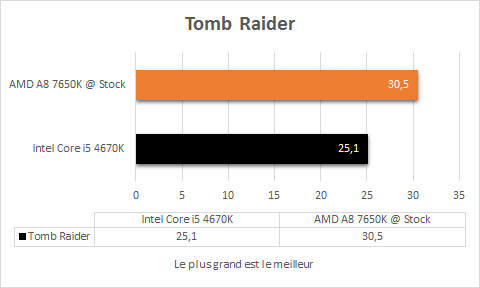
We can say that the GPU part of the AMD A8 7650K has it in the belly (all things considered), it is indeed much faster than the HD4600 of the Core i5, there is no need to procrastinate. Under 3DMark and Unigine Heaven 4 the GPU scores go from 901 and 544 respectively for the HD4600 to 1331 and 638 for the R7 of our test processor, a clear advantage. In real conditions and graphics settings more suited to the available power (therefore normally with antialiasing disabled) our friend A8 from AMD widens the gap further with 30.5 FPS in Tomb Raider and 25.63 FPS in Bioshock Infinite against 25.1 FPS and 16.96 FPS for the HD4600.
To sum up, the integrated GPU is really a step forward for a machine without an independent graphics card but capable of running games while taking care to deactivate the most demanding graphics options.
Consumption
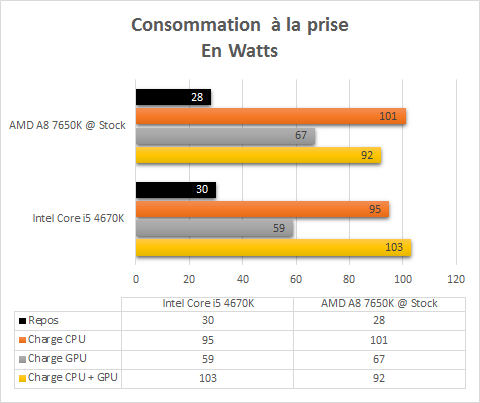
As we can see the consumption is very close to the 2 machines, but all is not really equal, the motherboard is not the same so we will have to put the results into perspective. At rest we are at 28 Watts for the full configuration at the outlet, it is not the A8 7650K that will skyrocket your electricity bill;). In load and according to the use of the processor consumption fluctuates, indeed if only the CPU part is in load, we go up to 101 Watts (always the complete configuration!) For 67 Watts with only the GPU part loaded, a CPU + GPU load stabilizes everything at 92 Watts.
Why is the consumption less when the CPU and GPU are simultaneously under load? Quite simply because when this happens the CPU part is under-clocked at 2.8 Ghz with a lower voltage, suddenly a drop in general consumption to stay in the TDP of 95 Watts.
AMD had the good taste to leave the multiplier unblocked on the A8 7650K in order to let little overclockers have fun gaining a little performance. Is the little man inclined to increase in frequency? Let’s see it all!
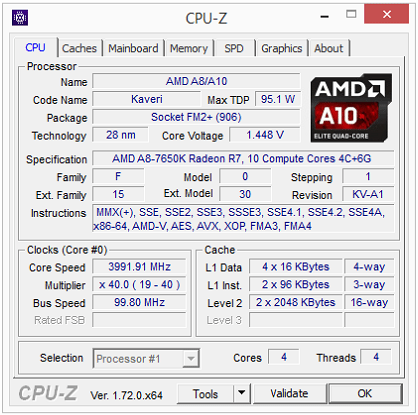
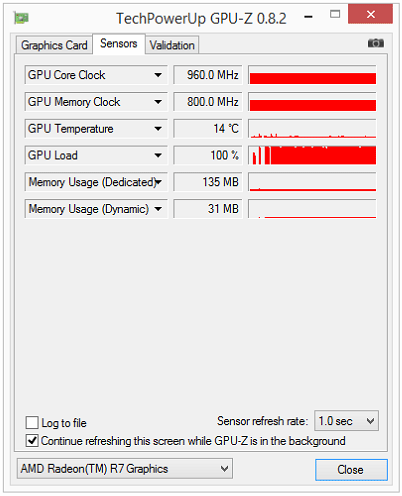
The CPU part could be increased to 4 GHz for the 4 simultaneous cores under load (instead of the 3.5 GHz observed) and the GPU part to 960 MHz (+ 240 MHz), we can say that it is not bad for an APU! The gain should be interesting in practice without changing the situation.
On the other hand, and as I observed above, an interesting test consists in seeing how these frequencies react on load, if individually they both remain at the maximum frequency of the overclock (therefore 4 GHz for the CPU and 960 MHz for GPU) what about simultaneous charging? Let’s see:
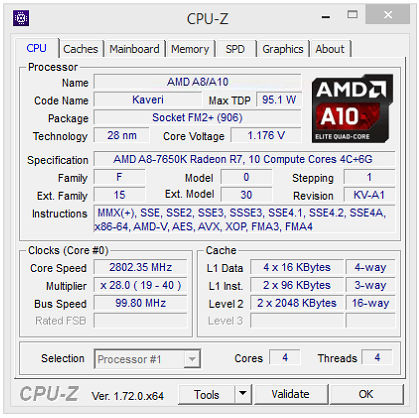
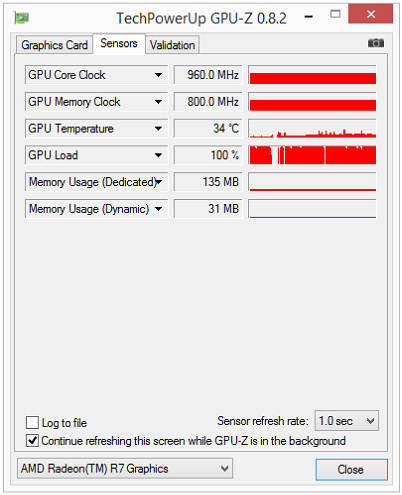
It is clear that only the GPU remains at its maximum frequency of 960 MHz against the processor part which goes down to the same values as the original, namely 2.8 GHz. However, the impact in the game will be much greater with a faster graphics card than a faster processor.
Overclocking Applications

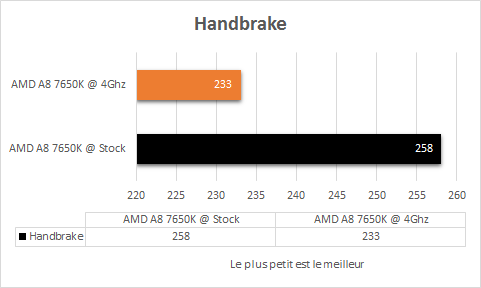
Nothing out of the ordinary in terms of results, the processor goes from 3.5 GHz with all cores loaded to 4 GHz (+ 14%) and the scores increase accordingly by 10 to 15%. The gain is there even if it will not turn the processor into a racehorse!
3D Overclocking and Games
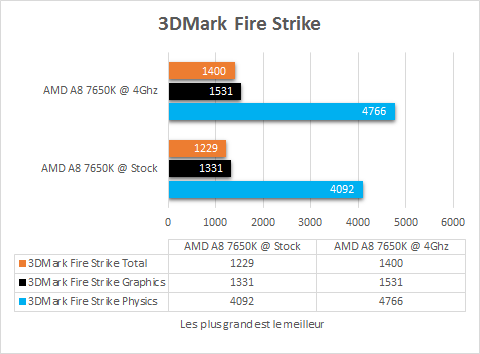


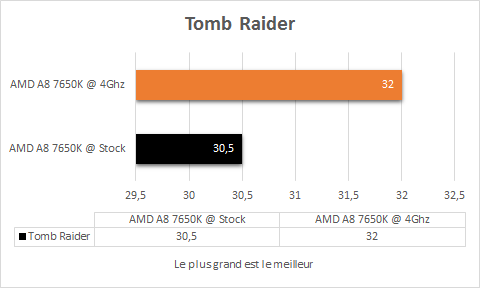
Like the CPU part once the GPU is overclocked (from 720 MHz to 960 MHz) the gain is interesting, gaining 15% under 3DMark Fire Strike Graphics, 12% FPS under Bioshock Infinite and 5% in Tomb Raider. Again this doesn’t radically change the processor but in the end games will benefit from overclocking at the GPU level more than overclocking at the processor level, it’s always good to take.
Overclocking Consumption
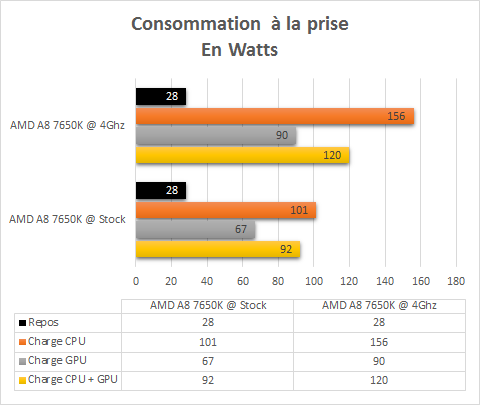
Consumption is always the main problem (with temperature) of overclocking and the A8 7650K is no exception to the rule, even if at rest there is no difference once the CPU is on load, we go from 101W to 156W, the GPU as for him once in load goes from 67W to 90W which is in the end rather contained. The complete configuration with a load on the CPU and the GPU simultaneously under load goes from 92W to 120W, which is normal since the CPU is under clocked at 2.8 GHz, as at the original frequencies.
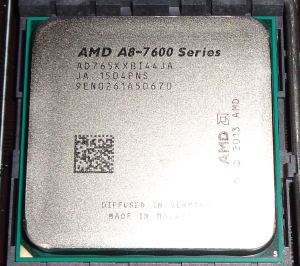
Here we are at the end of this test, what about the A8 7650K from AMD?
AMD offers here an APU with an integrated graphics part and does it well, the processor part will be largely sufficient for office use (email, surfing the internet, playing videos, occasional encoding of videos …) while being possible to playing the games on an occasional basis and / or paying close attention to graphic details (don’t expect to play full or even at 60 FPS). In addition to that the 7650K version has an unlocked multiplier and it will therefore be possible to increase the performance of the beast a little (CPU or GPU), which is always good to take.
Offered at a price of around 100 € it will be, coupled with a “small” motherboard (like the MSI A68HM-P33 in the test, i.e. around 45 €) a very good starting point for an entry-level PC config combining low consumption, acceptable performance and ability to play games with low consumption, especially since if the need really arises it will be possible to add a dedicated graphics card (such as an R9 280 for example).
The –
- Performance in games

A big thank you to Yann from Text100 who allowed me to do this test!
Where to find the AMD A8 7650K?
[phpzon asin= »B00TQIT1W0″ country= »FR » trackingid= »conseil-config-21″ merchantid= »Amazon » templatename= »conseil »]















